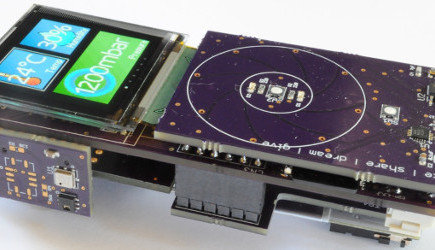Open Hardware Tricorder May Take Its Maker Into Space
October 16, 2014
on
on

Star Trek tricorders help space travelers explore the phenomena of the universe that lie beyond the human senses. Peter Jansen has been building tricorders for 7 years, now he's finalizing his latest iteration the pocket-sized open hardware Arducorder Mini with 12 sensor modalities.
The Arducorder Mini is an Arduino-compatible sensing and computing tool sporting atmospheric, electromagnetic and spatial sensors. Its a modular design with 5 sensor boards to support replacement and upgrading. The small screen displays live sensor data and because it is organized in tiles multiple sensor outputs can be accessed at the same time. A Wi-Fi module makes it easy to upload sensor data to other devices.
Open hardware
Jansen's aims to put a tricorder in the hands of anyone who wants one. Therefore he focuses on creating a low-cost device that makes it easy to share sensor data. Six different prototypes have preceded the Arducorder Mini, the first two he documented extensively in the hope to get a hardware development community started. Though he got lots of positive reactions, he realized that the project was too complex, too idiosyncratic for people to join in. After that he changed his approach and placed the emphasis on creating a device that would invite people to start learning in order to be able to participate. By means of video's, diagrams and other source files he shares the project's progress on The Tricorder Project website and Hackaday.
Taking the tricorder into space
Jansen has entered The Hackaday Prize, a competition of the hardware hacking website challenging contestants to submit their self-made connected device of the future. The grand prize? A trip to space! Jansen, who thought it be funny if the guy who builds a tricorders actually found himself in space, has now bested over 800 contestants and made it to the final five.
The sensors included in the Arducorder Mini:
Atmospheric Sensors
Ambient Temperature and Humidity: Measurement Specialties HTU21D
Ambient Pressure: Bosch Sensortec BMP180
Multi-gas sensor: SGX-Sensortech MICS-6814
Electromagnetic Sensors
3-Axis Magnetometer: Honeywell HMC5883L
Lightning sensor: AMS AS3935
X-ray and Gamma Ray Detector: Radiation Watch Type 5
Low-resolution thermal camera: Melexis MLX90620 16×4
Home-built linear polarimeter: 2x TAOS TSL2561
Colorimeter: TAOS TCS3472
UV: Silicon Labs Si1145
Spectrometer: Hamamatsu C12666MA micro-spectrometer, with Neo Pixel light source
Spatial Sensors
Inertial Measurement Unit: Invensense MPU-9150 9-axis (3-axis accelerometer, gyro, and magnetometer)
Other Sensors
Microphone: Analog Devices ADMP401
The Arducorder Mini is an Arduino-compatible sensing and computing tool sporting atmospheric, electromagnetic and spatial sensors. Its a modular design with 5 sensor boards to support replacement and upgrading. The small screen displays live sensor data and because it is organized in tiles multiple sensor outputs can be accessed at the same time. A Wi-Fi module makes it easy to upload sensor data to other devices.
Open hardware
Jansen's aims to put a tricorder in the hands of anyone who wants one. Therefore he focuses on creating a low-cost device that makes it easy to share sensor data. Six different prototypes have preceded the Arducorder Mini, the first two he documented extensively in the hope to get a hardware development community started. Though he got lots of positive reactions, he realized that the project was too complex, too idiosyncratic for people to join in. After that he changed his approach and placed the emphasis on creating a device that would invite people to start learning in order to be able to participate. By means of video's, diagrams and other source files he shares the project's progress on The Tricorder Project website and Hackaday.
Taking the tricorder into space
Jansen has entered The Hackaday Prize, a competition of the hardware hacking website challenging contestants to submit their self-made connected device of the future. The grand prize? A trip to space! Jansen, who thought it be funny if the guy who builds a tricorders actually found himself in space, has now bested over 800 contestants and made it to the final five.
The sensors included in the Arducorder Mini:
Atmospheric Sensors
Ambient Temperature and Humidity: Measurement Specialties HTU21D
Ambient Pressure: Bosch Sensortec BMP180
Multi-gas sensor: SGX-Sensortech MICS-6814
Electromagnetic Sensors
3-Axis Magnetometer: Honeywell HMC5883L
Lightning sensor: AMS AS3935
X-ray and Gamma Ray Detector: Radiation Watch Type 5
Low-resolution thermal camera: Melexis MLX90620 16×4
Home-built linear polarimeter: 2x TAOS TSL2561
Colorimeter: TAOS TCS3472
UV: Silicon Labs Si1145
Spectrometer: Hamamatsu C12666MA micro-spectrometer, with Neo Pixel light source
Spatial Sensors
Inertial Measurement Unit: Invensense MPU-9150 9-axis (3-axis accelerometer, gyro, and magnetometer)
Other Sensors
Microphone: Analog Devices ADMP401
Read full article
Hide full article


Discussion (2 comments)